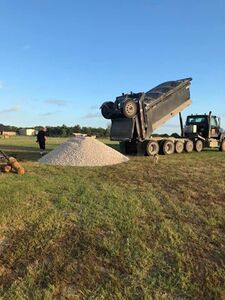Ballast: Difference between revisions
| Line 8: | Line 8: | ||
<gallery widths=300px heights=300px> | <gallery widths=300px heights=300px> | ||
File:2020-07-25 17.25.34.jpg|[[Daris A Nevil|Daris Nevil]] looks on as 16.7 yards are unloaded for the future International & Great Northern Railroad. Photo by Brenda Nevil, July 2020. | File:2020-07-25 17.25.34.jpg|[[Daris A Nevil|Daris Nevil]] looks on as 16.7 yards of 3/4 inch crushed limestone are unloaded for the future International & Great Northern Railroad. Photo by Brenda Nevil, July 2020. | ||
</gallery> | </gallery> | ||
Revision as of 12:42, 26 July 2020
Ballast is material such as gravel, crushed rock, slag, or cinders, placed on the roadbed to drain water away from the ties, to spread the load over softer subgrade and provide an even bearing for the ties; to hold ties more firmly in place and check the growth of grass and weeds. Ballasting improves the drainage, lessens dust, reduces weeding and maintenance problems, adds to the stability of the road, and makes smoother riding track.
Crushed Limestone
3/4 to 5/8 inch crushed limestone has been found to work well in Texas. It is relatively cheap ($24 per yard in July 2020). The rocks' rough edges help lock the ties into place, and allow ample drainage to keep the water away from the ties.
Daris Nevil looks on as 16.7 yards of 3/4 inch crushed limestone are unloaded for the future International & Great Northern Railroad. Photo by Brenda Nevil, July 2020.
Decomposed Granite
See Decomposed granite.
References
- "Ballast", The Miniature Locomotive, May-June 1953
- "Your RR Grading Methods?", Chaski.org
